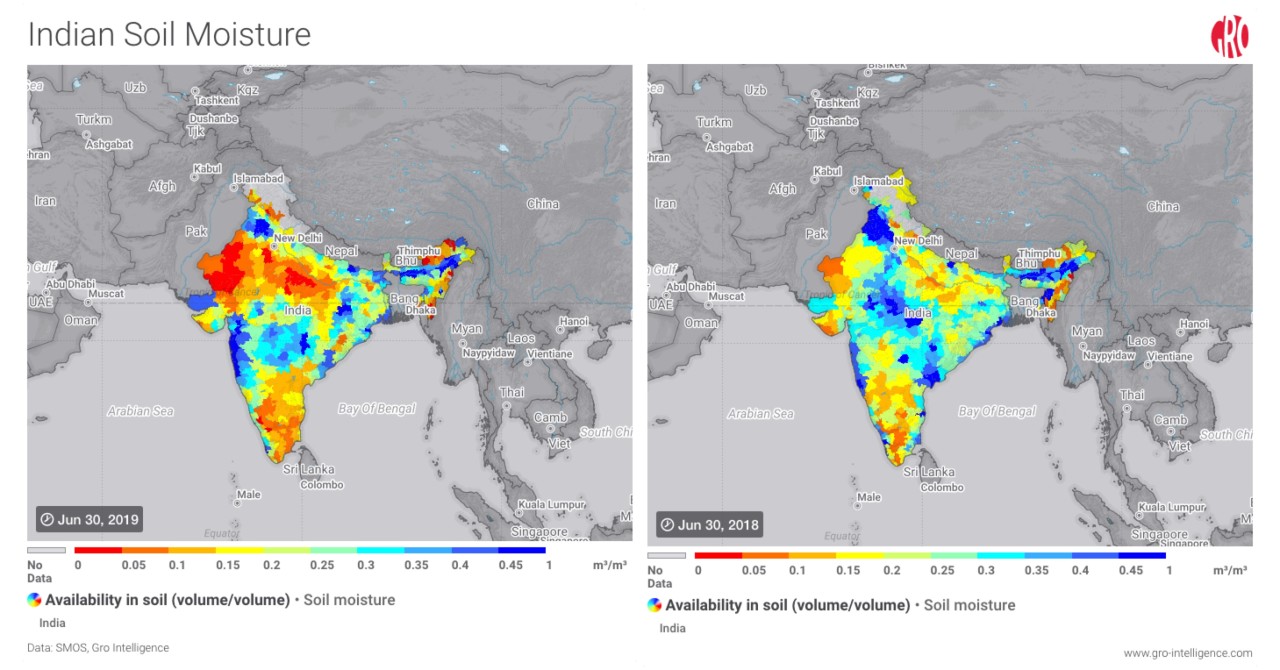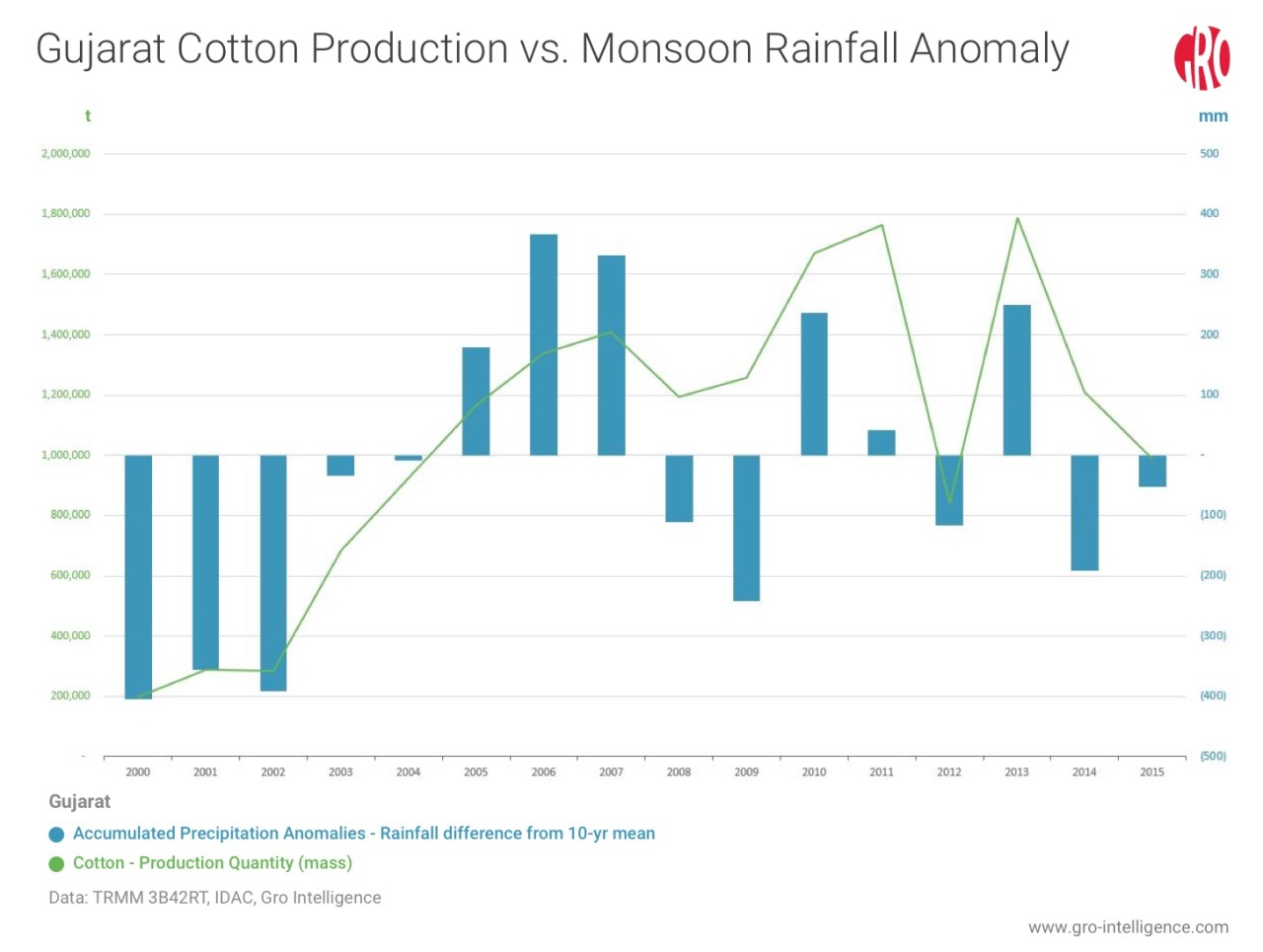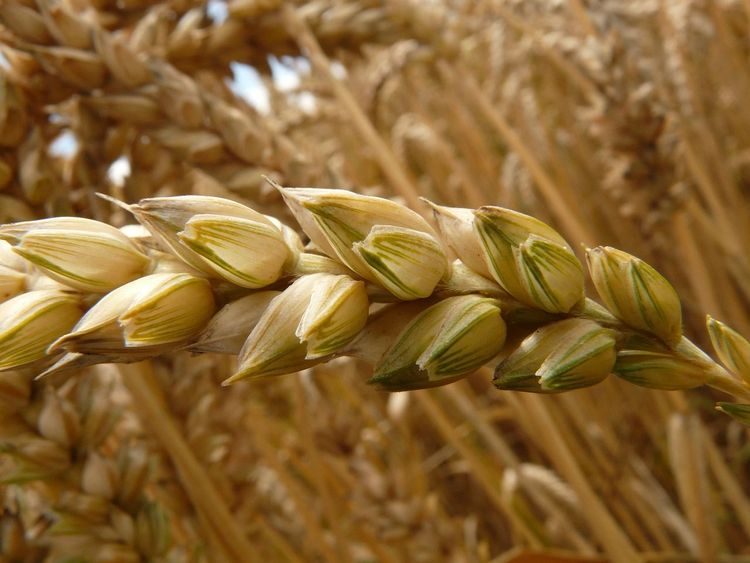India’s Monsoon: A Better Way to Assess Its Impact
India’s nearly 6-week-old monsoon has so far delivered a disappointing amount of rainfall needed to get crop planting off to a strong start.
The India Meteorological Department says rainfall from this year’s monsoon is currently 21% below normal. The country had its driest June in five years, and in some areas rainfall totals were nearly two-thirds below normal. That has affected planting progress: Pulse crops are 61% behind last year’s planting schedule, while oilseed and cotton crop plantings are more than 40% behind their usual pace.
It's too early to make any conclusions about the success of this year’s monsoon season, which runs from the beginning of June through September. Still, as we monitor the monsoon going forward, it will be important to track precipitation levels at the state level. Rainfall levels can vary greatly between regions in India, affecting crops in different ways. During the weak monsoon year of 2014, for example, India nevertheless had a bumper sugar crop that drove exports of the sweetener. And in 2004, there were good corn, soybean, and cotton crops despite a 12% deficit in average rainfall at the national level.
In this Featured Insight, we examine how many of India’s major crops fared during previous dry years. A historical analysis by Gro shows the value of monitoring growing conditions at a state level to more accurately determine the prospects of different crops at the national level.

The chart above shows district-level soil moisture in India on June 30 of this year (left) and at the same time last year (right). National rainfall as of this date was 33% below normal this year, although the distribution of the monsoon precipitation was uneven.
Tracking the Monsoon
Monsoons are the lifeblood of India’s farm economy. They provide more than three-quarters of India’s total annual rainfall. With limited access to irrigation, most farmers are fully dependent on the accumulation of precipitation during the period. (An exception is India’s large wheat crop, which is grown in winter, although moisture from monsoons can affect wheat planting.) Former Indian President Pranab Mukherjee called the climate phenomenon the “real” finance minister of the world’s second most populous nation. But monsoon rainfall also takes a toll on poorly built infrastructure and leads to numerous fatalities each year.
Monsoons develop as temperatures rise in the Thar Desert of northwest India, causing atmospheric pressure to drop and pulling moist air from the Indian Ocean across the country. The rains start in India’s southeastern state of Tamil Nadu, typically in early June, and progress in a northwesterly flow toward Pakistan, arriving there in mid-July in a normal year. Over the past 25 years, five monsoon seasons have resulted in precipitation totals more than 10% below normal, most recently in 2015.
Efforts to forecast monsoon rains focus in part on the El Nino-Southern Oscillation, or ENSO, signal. A strong positive signal, indicating El Nino conditions, typically suppresses rainfall during the monsoon, while La Nina conditions, a strong negative ENSO signal, support rainfall. This year, despite ENSO pointing to a weak El Nino, the India Meteorological Department called for normal monsoon rains, which the department defines as between 96% and 104% of the 50-year average.
Come June, however, the beginning of the monsoon was disappointing, exacerbating previously dry conditions. At the start of July, one month into the monsoon, rainfall was 33% behind the normal pace, delaying planting in some regions. The rainfall deficit has so far been blamed on the presence of a strong tropical cyclone in the Arabian Sea, Cyclone Vayu, that caused moderate damage in India and disrupted the monsoonal flow.
India’s crop health has ramifications on global markets. An insufficient wheat crop can force the country to import the grain for domestic consumption, including in 2016/17 when it imported as much as 7 million tonnes of wheat. The success of its sugar harvest can make India swing year to year between being an exporter or importer of the sweetener, rejiggering world supply-and-demand balances. India consumes nearly twice as much sugar annually as the second-largest consumer, China. India also is one of the world’s largest cotton producers.
Gro’s historical analysis sought to explain the relationship between annual monsoon rains and crop production in key producing Indian states. We used historical, satellite-derived precipitation data to calculate the accumulated surplus or deficit in rainfall during monsoons in those states for the 10-year period from 2001 through 2010. Those rainfall anomalies were then compared to the states’ annual crop production.
Cotton: Vying With China
Depending on the year, either India or China produce the largest cotton crops. India is the second-largest consumer of cotton, for its extensive textile industries, and it supplies 10% of world cotton import demand.
A third of India’s cotton production is concentrated in the northwestern state of Gujarat. It's often the last region of the country to see monsoon rains as they make their way across the subcontinent, and cotton production in the state is very closely linked to the seasonal precipitation. Our analysis found that the success of the cotton crop is 87% correlated with the rainfall accumulated during the June through September monsoon period. But a poor nationwide monsoon classification by the India Meteorological Department doesn’t always lead to a poor cotton crop in Gujarat. In 2004, adequate precipitation in the state nurtured a strong crop despite average overall dryness around the country.

The chart above shows June through September rainfall anomalies for Gujarat state (blue bars). The green line represents the state’s annual cotton production, which closely follows surpluses and deficits in precipitation. Our analysis found that cotton production was 87% correlated with rainfall in the monsoon period.
Conversely, India’s monsoons in 2000 and 2001 were in the normal range but left a disappointing national cotton crop. In those years, Gujarat state saw monsoonal rainfall totals at the bottom of the 20-year range. Gujarat production dropped to multiyear lows of just 200,000-300,000 tonnes.
Through July 4 of this year, accumulated precipitation in Gujarat is running 77 millimeters behind the 2001-2010 average level. That puts it in the middle of the past 20-year range of deviations from normal.
Sugar: Swing Importer
As with cotton, India greatly influences world sugar supplies. It's by far the world’s largest consumer of sugar, and its frequent shift from being a net exporter to a net importer from one year to the next means the Indian sugar crop is a key focus for market participants.
Sugarcane production in the country is dominated by the states of Uttar Pradesh and Maharashtra, where approximately 40% and 30% of India’s sugar is produced, respectively. Historical analysis shows that the crop’s success in Uttar Pradesh in northern India has little reliance on monsoonal rain, while the crop in centrally located Maharashtra is highly dependent on the summer rains. That's allowed relatively steady sugarcane production in Uttar Pradesh over the past 20 years while production in Maharashtra has varied depending on the strength of the monsoon rains. Between 2000 and 2017, the rainfall accumulation between the start of June and mid-September shows a 69% correlation with sugarcane production in Maharashtra. In Uttar Pradesh, the correlation is small and negative.

The charts above characterize sugarcane production in India. On the left, the blue line represents total national production and the green bars and red bars show production in Maharashtra and Uttar Pradesh, respectively, the largest producing states. The variability in monsoon rainfall has caused large swings in Maharashtra’s annual production while production in Uttar Pradesh has historically been much more stable. On the right, accumulated precipitation anomalies from June through September in Maharashtra (blue bars) are presented along with the state’s annual sugarcane production (green line). Monsoon rainfall is highly correlated with sugarcane production in the state.
Most recent national monsoon failures resulted in precipitation deficits in Maharashtra. One exception was in 2014, when Maharashtra saw above-normal rainfall and sugarcane production despite a poor overall Indian monsoon. And, in 2003, with a normal national monsoon, Maharashtra rainfall was well below normal and sugarcane production dropped 50% below trend.
Maharashtra precipitation this year through July 4 is running 59 millimeters behind the 2001-2010 average level. Only 25% of the past 20 years have seen larger deficits.
Soybeans and Corn: Food Source
While India isn’t a central player on the global corn and soybean stage, the impact on domestic food availability is important. In strong production years, India can export soybean meal to Southeast Asia and curb overall demand for imports from the Americas. India is also a major vegetable oil importer, and reduced oilseed production can force additional imports.
The relationship between soybean production and monsoon rainfall in the main producing state of Madhya Pradesh proved to be the weakest of the crop-state pairs explored in our analysis. Madhya Pradesh, in north-central India, produces roughly 60% of the country’s soybeans. The correlation between monsoon rainfall and production reaches just 44% in the June through mid-September period. The poor 2009 monsoon left a sizable rainfall deficit in Madhya Pradesh, but the state’s bean production was still 13% above trend. Similar precipitation deficits in the state in 2002 and 2014 yielded crops 40% and 4% below trend, respectively. In 2013, rainfall was so excessive that it drove production 28% below normal.

Strong soybean crops in India have historically allowed the country to export soybean meal to livestock producers in Southeast Asia and limited soybean meal demand from the Americas. On the left above, the strong relationship between soybean production in India (green line) and the country’s soybean meal exports (blue line) is shown. On the right, accumulated precipitation anomalies from June through September in Madhya Pradesh (blue bars) are charted against that state’s annual soybean production (green line). Unlike with other summer crops, soybeans don’t correlate well with monsoonal rainfall in the largest soybean producing state.
Karnataka in southern India, one of the first states to see the monsoonal flow each year, is the largest corn producing area. That early summer arrival has often allowed good precipitation to accumulate in the state even if the monsoon is slow to cover the subcontinent. Poor monsoon years of 2004 and 2014 still saw good Indian corn crops with strong production in Karnataka. It grew crops that were 6% and 8% above trend, respectively, in those years. In 2014, Karnataka precipitation was well above normal despite the national trend. In another nationally deficient monsoon year, 2009, the state received excessive rains, and corn production was weak. State-level monsoon rains proved to be highly correlated to the state’s corn production at 71%.
Through July 4 this year, accumulated monsoon rainfall in Karnataka is running 41 millimeters above the 2001-2010 average level. It's the third-highest precipitation surplus in the past 20 years.
Conclusion
As this year’s monsoon washes over India, anxieties are elevated. There is currently a sizable precipitation deficit. However, a simple Gro analysis shows monsoon failures don’t drive a universal decline in production across all crops and all Indian states. State- and district- level data for rainfall and crop production allow analysts to create a clearer picture of the real impact of monsoons. Numerous historical examples show adequate, and sometimes excessive, rainfall totals in key crop-producing states even during poor monsoon years. In addition, crops have varying sensitivities to seasonal precipitation dynamics—Gujarat’s cotton crop is highly correlated to the seasonal rains, for example, while soybeans in Madhya Pradesh are less affected. Gro’s extensive subnational data allows one to better quantify the risk of a poor monsoon.

 Insight
InsightPrices Surge for Cocoa, Coffee, and Other ‘Soft’ Commodities
 Blog
BlogGain Actionable Insight Into Climate Impacts With The Gro Climate Ensemble
 Insight
InsightGro’s 2024 Watchlist: 3 Forces Shaping Global Climate Risk in the Year Ahead
 Insight
Insight

 Search
Search